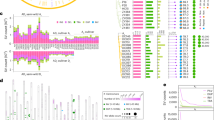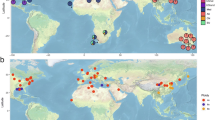Abstract
Genome size determinations were coupled with allozyme and mtDNA studies to gain insights into the origin of polyploidy and clonal diversity in populations of Daphnia tenebrosa from Churchill, Manitoba. Allozymic variation at five enzyme loci allowed the detection of 32 clones. Analyses of 73 populations in 1981, 27 in 1987 and 45 in 1991 revealed that clonal frequencies were relatively stable and that D. tenebrosa was more clonally diverse (average of three clones per pond) than other species of the D. pulex complex at the same site. Genome size determinations revealed the presence of two clonal assemblages with averages of 0.53 (± 0.01) pg and 0.89 (± 0.03) pg, corresponding to diploid and tetraploid clones. Clustering of allozyme distances revealed three groups, with no association between ploidy level or pigmentation. Similarly, diploid and polyploid clones did not form distinct clusters on the mtDNA dendrogram. The high sequence divergence between the two mtDNA clusters as well as the lack of correspondence between allozyme distance and mtDNA divergence among clonal pairs both suggest that polyploidy arose following reciprocal hybridizations between genetically divergent populations of this species.
Similar content being viewed by others
Article PDF
References
Beaton, M J, and Hebert, P D N. 1988. Geographical parthenogenesis and polyploidy in Daphnia pulex. Am Nat, 132, 837–845.
Beaton, M J, and Hebert, P D N. 1989. Miniature genomes and endopolyploidy in cladoceran crustaceans. Genome, 32, 1048–1053.
Beaton, M J, and Hebert, P D N. 1994. Variation in chromosome numbers in Daphnia. (Crustacea, Cladocera) Hereditas, 120, 275–279.
Bell, G. 1982. The Masterpiece of Nature: the Evolution and Genetics of Sexuality. University of California Press, Berkeley.
Bierzychudek, P. 1985. Patterns in plant parthenogenesis. Experientia, 41, 1255–1263.
Brooks, J L. 1957. The systematics of North American Daphnia. Mem Conn Acad Arts Sci, 13, 1–180.
Browne, R A. 1992. Population genetics and ecology of Anemia: insights into parthenogenetic reproduction. Trends Ecol Evol, 7, 232–237.
Christensen, B, Noer, H, and Theisen, B F. 1988. Differential responses to humidity and soil type among clones of triploid parthenogenetic Trichoniscus pusillus (Isopoda, Crustacea). Hereditas, 108, 213–217.
Crease, T J, Stanton, D J, and Hebert, P D N. 1989. Poly- phyletic origins of asexuality in Daphnia pulex. II. Mitochondrial DNA variation. Evolution, 43, 1016–1026.
Dufresne, F, and Hebert, P D N. 1994. Hybridization and origins of polyploidy. Proc R Soc B, 258, 141–146.
Ellstrand, N C, and Rose, M L. 1987. Patterns of clonal diversity in clonal plant species. Am J Bot, 74, 123–131.
Felsenstein, J. 1993. PHYLIP (Phytogeny Inference Package). Version 3.5c. Department of Genetics, University of Washington, Seattle, U.S.A.
Hebert, P D N. 1987. Genotypic characteristics of the Cladocera. Hydrobiologia, 145, 183–293.
Hebert, P D N, and Beaton, M J. 1989. Methodologies for Allozyme Analyses Using Cellulose Acetate Electrophoresis. Helena Laboratories, Beaumont, TX.
Hebert, P D N, Beaton, M J, Schwartz, S S, and Stanton, D J. 1989. Polyphyletic origins of asexuality in Daphnia pulex. I. Breeding-system variation and levels of clonal diversity. Evolution, 43, 1004–1015.
Hebert, P D N, and Crease, T. 1983. Clonal diversity in populations of Daphnia pulex reproducing by obligate parthenogenesis. Heredity, 51, 353–369.
Hebert, P D N, and McWalter, D B. 1983. Cuticular pigmentation in arctic Daphnia: adaptive diversification of asexual lineages? Am Nat, 111, 286–291.
Hebert, P D N, Schwartz, S S, Ward, R D, and Finston, T L. 1993. Macrogeographic patterns of breeding system diversity in the Daphnia pulex group. I. Breeding systems of Canadian populations. Heredity, 70, 148–161.
Hobaek, A, Weider, L J, and Wolf, H G. 1993. Ecological genetics of Norwegian Daphnia. III. Clonal richness in an Arctic apomictic complex. Heredity, 71, 323–330.
Krebs, C J. 1989. Ecological Methodology. Harper and Row, New York.
Lewis, W H. 1980. Polyploidy: Biological Relevance. Plenum Press, New York.
McElroy, D, Moran, P, Bermingham, E, and Kornfield, I. 1991. The Restriction Enzyme Analysis Package. Version 4. University of Maine, Orono, ME.
Mogie, M. 1986. On the relationship between asexual reproduction and polyploidy. J Theor Biol, 111, 493–498.
Nei, M. 1978. Estimation of average heterozygosity and genetic distance from a small number of individuals. Genetics, 89, 583–590.
Nei, M, and Tajima, F. 1983. Maximum likelihood estimates of the number of nucleotide substitutions from restriction sites data. Genetics, 105, 207–217.
Parker, E D. 1979. Ecological implications of clonal diversity in parthenogenetic morphospecies. Am Zool, 19, 753–762.
Sneath, P H A, and Sokal, R R. 1973. Numerical Taxonomy, the Principles and Practice of Numerical Classification. W. H. Freeman, San Francisco, CA.
Soltis, D E, and Soltis, P S. 1993. Molecular data and the dynamic nature of polyploidy. Crit Rev Plant Sci, 12, 243–273.
Stanton, D J. 1988. Evolution of Asexuality in D. pulex: Implications of Mitochondrial DNA Analysis. Ph. D. Thesis, University of Windsor, Canada.
Stebbins, G L. 1947. Types of polyploids: their classification and significance. Adv Genet, 1, 403–429.
Swofford, D L, and Selander, R B. 1989. Biosys-I. A computer program for the analysis of allelic variation in population genetics and biochemical systematics. Illinois Natural History Survey, Champaign.
Taylor, D J, and Hebert, P D N. 1993. Habitat-dependent hybrid parentage and differential introgression between neighboringly sympatric Daphnia species. Proc Natl Acad Sci USA, 90, 7079–7083.
Thompson, K. 1990. Genome size, seed size and germination temperature in herbaceous angiosperms. Evol. Trends Plants, 4, 113–116.
Van Raay, T J, and Crease, T J. 1995. Mitochondrial DNA diversity in an apomictic Daphnia complex from the Canadian high arctic. Mol Ecol (in press).
Ward, R D, Bickerton, M A, Finston, T, and Hebert, P D N. 1994. Geographical cline in breeding systems and ploidy levels in European populations of Daphnia pulex. Heredity, 73, 532–543.
Weider, L J, Beaton, M J, and Hebert, P D N. 1987. Clonal diversity in high-arctic populations of Daphnia pulex, a polyploid apomictic complex. Evolution, 41, 1335–1346.
Weider, L J, and Hebert, P D N. 1987a. Microgeographic genetic heterogeneity of melanic Daphnia pulex at a low-Arctic site. Heredity, 58, 391–399.
Weider, L J, and Hebert, P D N. 1987b. Ecological and physiological differentiation among low-arctic clones of Daphnia pulex. Ecology, 68, 188–198.
Weider, L J, and Hobaek, A. 1994. Molecular biogeography of clonal lineages in a high-arctic Daphnia pulex complex. Mol Ecol, 3, 497–506.
Wilson, C C, and Hebert, P D N. 1992. The maintenance of taxon diversity in an asexual assemblage: an experimental analysis. Ecology, 73, 1462–1472.
Zhao, Y, and King, C E. 1989. Ecological genetics of the rotifer Brachionus plicatilis in Soda Lake, Nevada, USA. Hydrobiologia, 185, 175–181.
Zhang, L, and Lefcort, H. 1992. The effects of ploidy level on thermal distributions of brine shrimp Artemia parthenogenetica and its ecological implications. Heredity, 66, 445–452.
Acknowledgements
This research was supported by a FCAR scholarship and DINA Northen Training grants to F. D., as well as by a research grant from NSERC to P. D. ?. ?. Many people collaborated in this long-term study. N. Baby carried out most of the genome size analyses, R. Barrette helped with the electrophoresis, while P. Gajda and M. Cornish provided assistance in the field. We thank M. Beaton for helpful comments on earlier drafts of the manuscript.
Author information
Authors and Affiliations
Rights and permissions
About this article
Cite this article
Dufresne, F., Hebert, P. Polyploidy and clonal diversity in an arctic cladoceran. Heredity 75, 45–53 (1995). https://doi.org/10.1038/hdy.1995.102
Received:
Issue date:
DOI: https://doi.org/10.1038/hdy.1995.102
Keywords
This article is cited by
-
Fall Composition of Storage Lipids is Associated with the Overwintering Strategy of Daphnia
Lipids (2017)
-
Impact of ploidy level on the distribution of Pokey element insertions in the Daphnia pulex complex
Mobile DNA (2014)
-
Evolution of a transposon in Daphnia hybrid genomes
Mobile DNA (2013)
-
Differential survival among genotypes of Daphnia pulex differing in reproductive mode, ploidy level, and geographic origin
Evolutionary Ecology (2010)
-
Modeling protein network evolution under genome duplication and domain shuffling
BMC Systems Biology (2007)



